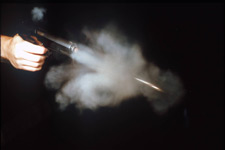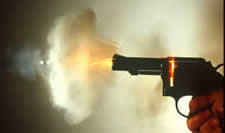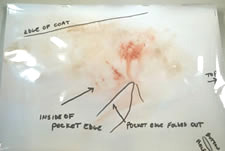Home | Glossary | Resources | Help | Contact Us | Course Map
Archival Notice
This is an archive page that is no longer being updated. It may contain outdated information and links may no longer function as originally intended.
Powders and Residues
Burned or partially burned bullet propellants and other gunshot residues are expelled from the muzzle during the firing process and can be used to determine the distance of a muzzle from a garment or other surface at the time of discharge.
Read more about propellants in Module 03.
When a firearm discharges, the burning of the propellant powder immediately generates a large amount of heat and gas inside the cartridge, providing the pressure required to expel the bullet.
Gunshot residues are composed of the following:
- Primer residues from the combustion of the cartridge priming mixture when the primer was struck by the firing pin
- Residues resulting from the burning of the propellant
- Material generated by the interaction of the bullet with the inside of the barrel
- Unburned and partially burned powder
Examination
When a firearm is discharged and the bullet strikes a surface, gunshot residues are deposited, particularly at close range. These residues may be reproducible and therefore have evidentiary value. Some residues are visible and others require chemical treatment in order to visualize them.
| Note: |
| Evidence should be received and handled according to laboratory protocol. |
Read more about evidence handling in Module 06.
Examination Documentation
Visual, microscopic, and chemical examinations should be documented according to laboratory protocol. Written documentation can be supplemented with images of items indicating the presence of physical effects and gunshot residues
Additional Online Courses
- What Every First Responding Officer Should Know About DNA Evidence
- Collecting DNA Evidence at Property Crime Scenes
- DNA – A Prosecutor’s Practice Notebook
- Crime Scene and DNA Basics
- Laboratory Safety Programs
- DNA Amplification
- Population Genetics and Statistics
- Non-STR DNA Markers: SNPs, Y-STRs, LCN and mtDNA
- Firearms Examiner Training
- Forensic DNA Education for Law Enforcement Decisionmakers
- What Every Investigator and Evidence Technician Should Know About DNA Evidence
- Principles of Forensic DNA for Officers of the Court
- Law 101: Legal Guide for the Forensic Expert
- Laboratory Orientation and Testing of Body Fluids and Tissues
- DNA Extraction and Quantitation
- STR Data Analysis and Interpretation
- Communication Skills, Report Writing, and Courtroom Testimony
- Español for Law Enforcement
- Amplified DNA Product Separation for Forensic Analysts




